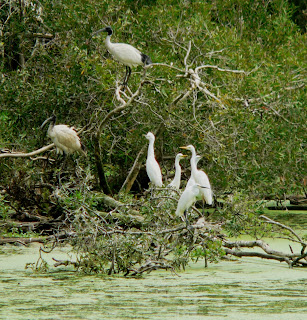This Fairy Gerygone was singing today at Mudjimba on the Sunshine Coast. There are six pairs of this species in a 3-km stretch of coastal vine scrub in the vicinity. I've also seen the bird elsewhere along the coast including Noosa National Park and Coolum. Occasionally in turns up in the hinterland - at Ninderry, Kenilworth and Bli Bli - but it does not appear to be resident there.
Until relatively recent years, Fairy Gerygone was not known to occur south of the Gin Gin-Childers region. Whether it has spread southward or was overlooked in the past is not known; this is one of several essentially tropical species which appears to be extending its range south. In the Sunshine Coast littoral scrubs, it occurs side by side with Mangrove Gerygone. More rarely in the hinterland, it may be in the same habitat as Brown Gerygone, which is absent from the coastal scrubs.
In the nearby grasslands of the Maroochy River flats, I had an adult and a juvenile Spotted Harrier, the juvenile pictured here. This species, normally associated with the arid inland, has been seen throughout the year in the vicinity and it is likely to be breeding here.
An Australian Hobby was perched on the wires. Other raptors seen included Grey Goshawk and Brown Goshawk.
In grassland inundated by recent rains, I had no fewer than 6 Spotless Crakes calling. I had not previously associated the species with this kind of habitat.
Until relatively recent years, Fairy Gerygone was not known to occur south of the Gin Gin-Childers region. Whether it has spread southward or was overlooked in the past is not known; this is one of several essentially tropical species which appears to be extending its range south. In the Sunshine Coast littoral scrubs, it occurs side by side with Mangrove Gerygone. More rarely in the hinterland, it may be in the same habitat as Brown Gerygone, which is absent from the coastal scrubs.
In the nearby grasslands of the Maroochy River flats, I had an adult and a juvenile Spotted Harrier, the juvenile pictured here. This species, normally associated with the arid inland, has been seen throughout the year in the vicinity and it is likely to be breeding here.
An Australian Hobby was perched on the wires. Other raptors seen included Grey Goshawk and Brown Goshawk.
In grassland inundated by recent rains, I had no fewer than 6 Spotless Crakes calling. I had not previously associated the species with this kind of habitat.


















































